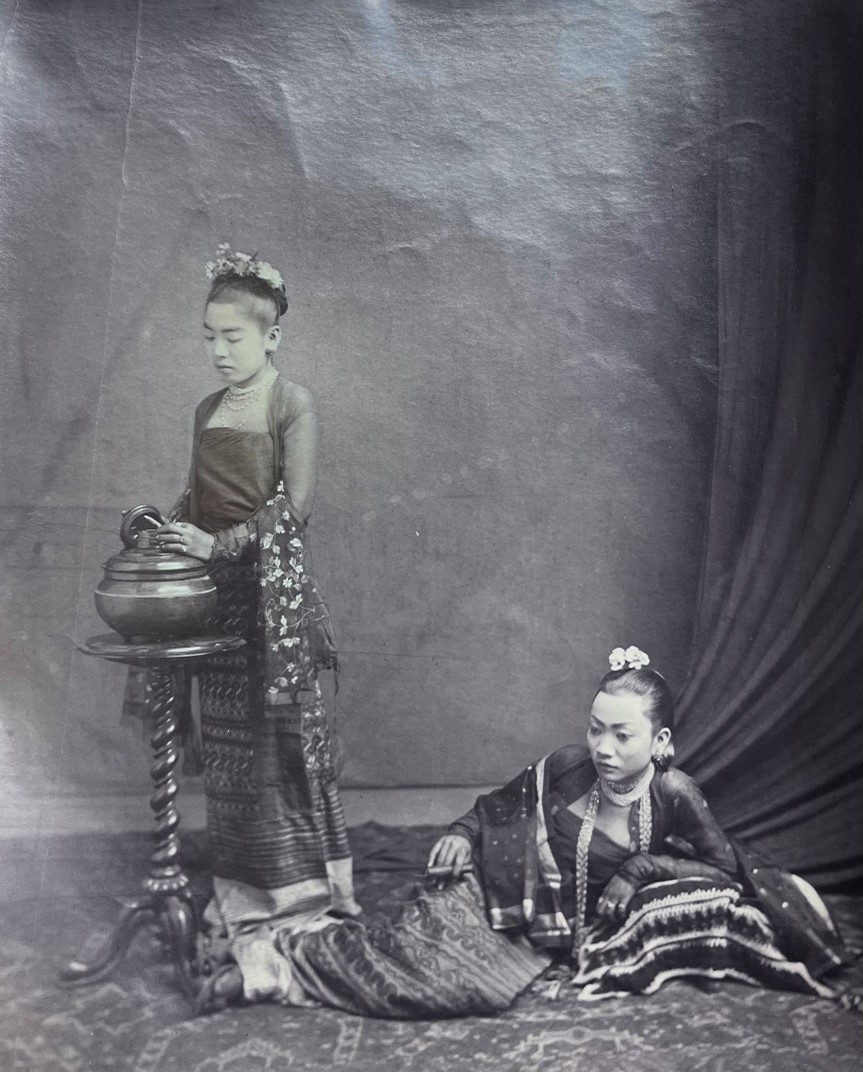Presently known as Myanmar, Burma has a long and rich history. The early remnants of Burmese civilization are estimated by anthropologists to be over 3,500 years old, as confirmed by bronze artifacts found in the Irawaddy valley. The nation has undergone the rise and fall of several dynasties and ruling classes, all of whom sought to unify the occupying peoples. Few succeeded in their efforts, with the Bayinnaung Empire being one of two that succeeded in their efforts. Even the Bayinnaung Empire, however, met its demise in 1885 under the imperial rule of Britain.[1] The Empire fought three separate wars against Britain in defense of its sovereignty, the first of which began in 1824. Unfortunately, the Anglo-Burmese Wars resulted in the complete loss of national autonomy for the Burmese people who now found themselves under British rule. During this time, photography served as a means of depicting and “conveying information about unknown cultures and regions.”[2] It was under British imperial control that the photo presently found in the Rare and Distinctive Collections of CU Boulder, “Burmese Ladies of Wealth”, was taken. The exact date of the photo is not recorded but was taken under British colonialism. Burmese Ladies of Wealth presents a staged depiction of Burmese high-class culture that exhibits indications of Western influence in Burma during the time of its colonization from 1823 to 1948.
Burmese Ladies of Wealth as seen above displays two Burmese women photographed beside one another. One is standing above an intricately carved table observing the contents of what appears to be a metal vase. This woman looks no older than eighteen years of age. The other woman highlighted in the photo is laying gracefully on the ground to the right of the other woman. She is glancing intently at something on the floor that is placed outside of the shot. The two women are dressed in lavish silks and fabrics with pearls draped from their necks. The photo is in Black and white yet silks and fabrics are likely very colorful. Their hair and makeup are done with great care. Flowers adorn their hair as if they are wearing crowns.
The photo adopts an air of grandeur as displayed through the expensive-looking clothing and the jewelry they are dawning. It was likely that this photo was taken by British colonizers, as was true with many photos taken during this time. This would explain the staged nature of the photo as well as the subjects. There were rarely any photos taken of Burmese people that were not staged, heavily altered, or used to serve the interests of the photographing body. Burmese Ladies of Wealth depicts early 18th-century British visual propaganda for both strategic and political advances. The image denotes that women were highly regarded in Burma during this time, yet this is far from the truth. During British colonization, Burmese women “were believed to be spiritually inferior to men despite the high status that [they] allegedly enjoyed.” [3] Regardless of the financial wealth some Burmese women enjoyed, they fundamentally lacked equality. Not only were the circumstances for Burmese women far from ideal but all indigenous peoples of Burma were affected, often negatively, by British colonialism. The British authorities not only undercut Burmese “political and religious authority,” but also maintained a violent rule. Many of the images taken in Burma by the British contributed to Propaganda campaigns that sought to portray a different image back in the Western Hemisphere.
Chie Ikeya, a historian at Rutgers University with a focus on Southeast Asia, delves into the implications of these historical photographs. Ikeya states that staged photos of Burmese women were utilized by both colonial forces and local peoples as a “key political strategy” to either “justify [or] de-legitimize colonial rule.”[4] Depicting Burmese women in a Westernized fashion dressed in expensive clothing, such as was done in Burmese Women of Wealth, allowed the British to proliferate the idea that Burma was becoming “modernized” under colonial rule. The concept of modernization was one that dominated much of Asia during this period and even influenced major events such as the Sino-Japanese War which occurred in China during the late 1800s. Images such as these, which were largely proliferated amongst Western powers and peoples, created the narrative that colonial rule was positively impacting “backward” Southeast Asian societies. Ikeya details how, despite the efforts of such campaigns to appear successful, women in Burma did not enjoy the high-status and egalitarian circumstances the photos implied.
Burmese Woman of Wealth is a rich photograph depicting far more than what meets the eye. Its chosen subjects, staged nature, attention to detail, and choice of clothing and jewelry tell the story of British Colonizers seeking to depict the Burmese people in a modern, high-class light to justify colonialism. While for this specific photo, the motivations behind its origins are being assumed, it is highly likely that this was the case.
Works Cited
“Captain Linnaeus Tripe: Photographer of India and Burma, 1852-1860.” Captain Linnaeus Tripe: Photographer of India and Burma, 1852-1860 – The Metropolitan Museum of Art, https://www.metmuseum.org/press/exhibitions/2015/captain-linnaeus-tripe#:~:text=of%20India%20and%20Burma%2C%201852%2D1860,-February%2024%E2%80%93May&text=Captain%20Linnaeus%20Tripe%20(1822%E2%80%931902,now%20Myanmar)%20in%20the%201850s.
Ikeya, Chie. People at Rutgers-Camden | Rutgers University. https://people.camden.rutgers.edu/cikeya/files/The_Traditional_High_Status_of_Women_in.pdf.
Godrej, Dinyar. “A Short History of Burma.” New Internationalist, 5 July 2017, https://newint.org/features/2008/04/18/history.
[1] Godrej
[2] Captain Linnaeus Tripe
[3] 56, Ikeya
[4] 53, Ikeya
